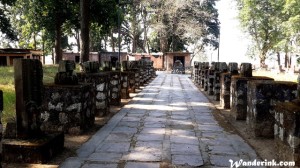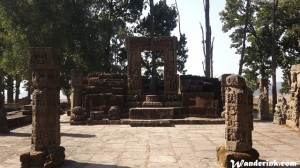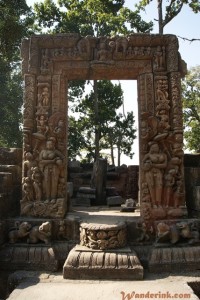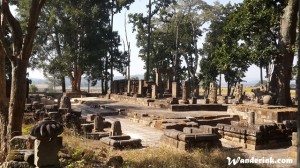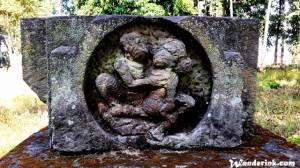The word ‘archaeology’ is Greek in origin and has nothing to do with monuments or heritage but simply means the ‘pursuit of ancient knowledge.’ While few of us pursue ancient knowledge ardently – or any knowledge for that matter – while on holiday, there is a certain joy we experience while visiting heritage sites – treasure troves of prehistoric civilisations, acmes of ancient creativity, epitomes of thought and design from an era gone by. More so when they are not overrun by tourists or hidden beneath unseemly structures erected in the name of preservation. Dipadih is one of those delightful anomalies where lack of visitors has paid put to development funds which in turn has meant less visitors.
The site is an ancient temple complex and possibly the best archaeological site in the whole of Chhattisgarh. With not much footfalls, in large part due to its remote north location (read ‘route’ later in the story) the site has remained pristine. The best part is that the fruit of the archaeological dig has been preserved not in museums but on the open ground; and thankfully no claustrophobic awnings either. Excavated stone pillars have been erected along the path next to the entrance on which are exhibited the mythical creatures and religious figures that were unearthed at the site. A walk through the path leading to the main Shiva Temple breathes life to an almost visceral connection to our past and the rich heritage. Exploring the site is like walking through a live excavation site – only that here the sculptures have been lined up neatly, washing off the grime and the mud, for an exclusive premiere. Pardon the Hallmark sentiment, but you feel truly special here. The main findings in the region include six major temples and 74 smaller ones dating from the 7th century onward, when the region was under the Kalachuri kings.
The main Shiva Temple is revered by the locals in the memory of King Samant Sarna who lost his life in battle centuries ago. The temple itself is quite unique in its craftsmanship, a celebration of perfection in everyday life. Thus there are images of the typical nayika (‘heroine’ literally) women characterised in sculptural art by alluring embonpoint – voluptuous breasts and well-rounded thighs. All around the complex are images of these nayikas in interesting postures – waiting for a lover, dancing, looking at themselves in the mirror. Keep an eye out for the one wearing a dissimilar pair of earrings. These nayikas are trendsetters, in stone: While mismatched earrings are popular with the tribal women of Sarguja even today, pop culture nayika Miley Cyrus wore one to a red carpet event last year.
There are regal-looking creatures roaring in alert sentry duty and the more pacific images of swans and beatific peacocks. There is a very unique statue of two lions with one head which can be seen on the adhisthana, the raised platform, of the temple. On the entrance doors to the temple there are the river goddesses Ganga and Yamuna, epitomising feminine grace and charm wearing jewellery and daintily coiffured. A magnificent Lord Shiva has been etched on to its arches. Around it is the Kalpavriksha (a wish-fulfilling tree in Hindu mythology) and a band of soldiers. A stroll around the temple will reveal grimacing men with severely twirled moustaches, the lower lips merging with the beards and tucked into the corners of the walls – their mouths are actually the exit for the drainage system. Creativity at its playful best.
Other notable sculptures among the excavations here include the images of a dancing and an unmoving Lord Ganesha. The statue of Uma Maheshwar (Shiva and consort Parvati) is the epitome in sculptural art – there is a clearly discernible smile across the face of Uma Maheshwar. The hair on their heads as well as the jewellery worn by Parvati has also been etched out brilliantly. The statue of Rudra Bhairava or Shiva in his destructive avatar, with a garland of heads around his neck is more feral than elsewhere for it is grinning as if enjoying the annihilation. There is Lord Brahma with facial hair, apparently not seen anywhere else in India. Most nook and enclosure lead to a Shivalinga ranging from five feet to a behemoth and an architectural marvel made from 108 smaller Shivlingas. The macho soldier, in a marked departure from his usual gallant stance, plucking out a thorn that has pricked the tender feet of his paramour is an enduring one as it is endearing. Chivalry was always in fashion!
At the time of visit towards the end of last year I saw some labourers laying the foundation for a building without any sort of supervision within the site obviously flouting all conservation norms.
“Whom are you guys working for?” I asked.
“Babloo contractor.”
Expecting an ‘ASI’ or ‘state archaeology department’ I could only gawk at them.
“You don’t know Babloo contractor?” They asked, unbelieving.
“Mmmhhhh,” I mumbled unable to cover my feeling of inadequacy.
It could be just a matter of time before the true heritage experience of Dipadih is obliterated by more of such recent arrivals. But till then truly a life enriching experience.
The route and snacking suggestions: Dipadih is best done as a day trip from Ambikapur. Take the exit to Rajpur 38 km away. The road is a well maintained double lane though it tapers in many places to a narrow strip. Like the rest of Ambikapur, you don’t encounter much traffic here either. But do keep an eye open for tractors or other vehicles that are obscured by hayricks stacked up by the side of the road. Vast open fields, ochreous-yellow stubs in the post-harvest season, embrace the tarmac from both sides. Sal trees cuddle over clusters of adobe houses many of which are under lock and key; with not much of work left in the fields, the villagers have moved to cities looking for work.
Locals vouch for the quality of the food one gets at the dhabas along this route; there are a few as you near Rajpur which serves some seriously appetising stuff. The samosas from these shops are a must-try; the potato used in the filling has a certain je ne sais quoi which can be said only for those coming from Mainpat nearby. Have it with the pathaka (literally meaning ‘firecracker’) or imli (tamarind) chutney. Though the road traces a blazing straight track most of the time, there are severe half-moons and blind inclines. From Rajpur, Dipadih is 42 km and the scenery only gets better. A very memorable drive made further enjoyable by relative emptiness of the road. Once you reach Dipadih town there is an unobtrusive turning to the left which cuts through unending fields till the excavation site marked by sprawling arboreal glory.
Distance: 80 km / Time: 1 hr 30 min
You can wipe out a generation of people, you can burn their homes to the ground and somehow they will still come back. But if you destroy their achievements and their history then it’s like they never existed. Just ash floating.
George Stout / Frank Stokes played by George Clooney in the true life drama ‘The Monuments Men’
(Except for a few minor additions, the above article is largely from a chapter in the guidebook ‘Experience Chhattisgarh on the road’ written and photographed by me for the Times Book Group.)



